Cross turkeys Big 6 was created by breeding, by the British firm Brutiss Unaited Tyurrkss in 2007. The paternal line BUT 8 and the maternal BIG 5 were used for breeding.
Bird refers to the meat type of productivity. Big 6 is a young cross, which appeared on the Russian market relatively recently, but has already managed to recommend itself due to its large mass, precocity and viability.
Table of contents
Description of cross-country Big 6
Big 6 turkeys are large and massive poultry with a squat body and a relatively small head. For white color and fluffy plumage this cross is easily distinguished from other species. White plumage is located all over the body, not counting the little black speck on the chest. Females are not as fluffy as males.
The plumage is quite dense and thick, with a characteristic brilliance. The appreciation of Big 6 turkeys is highly appreciated, due to its softness and lightness, it is in demand in industry. The back of the birds is flat and wide. The pectoral muscles are pronounced, bulging. Wings of large sizes.
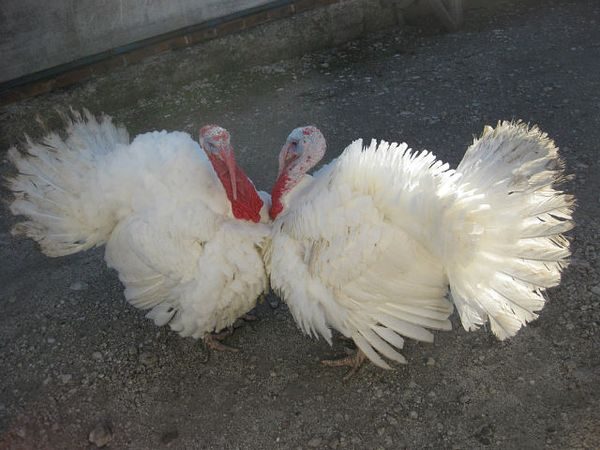
The bird stands on large, strong and sinewy legs. On the long neck is a small head. A distinctive feature of turkeys - the presence of coral, skin folds of red, located in the head and neck. On the upper part of the beak there is a dermal, vertically hanging down appendage, which, during the period of excitation of the bird, can reach 12-15 cm.
Turkeys have a lively temperament, they are strong enough and can stand up for themselves.As for community with other birds, conflict may arise, therefore it is recommended to keep broiler turkeys separately and by families. Below you can read about it in more detail.
Keeping and breeding turkeys at home
In industrial conditions, turkeys are kept in specially equipped large-sized windowless poultry houses on litter, with controlled lighting and a microclimate, and cellular contents are also often used.
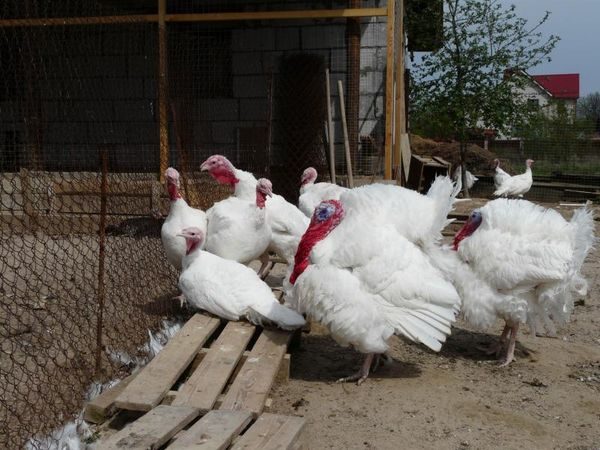
Cross Big 6 is bred not only in industrial enterprises, but also in home farms. The basic conditions for keeping turkeys do not practically differ from the requirements for poultry houses for other breeds. On summer home farms, turkeys are kept on a hike and are driven to the barn only for the night. The poultry house for turkeys should be capital.
The walls are built of brick or other durable materials, the floors are poured with concrete. If there are windows in the house, they should be opened, and in order for the bird not to fly away, they are covered with bars.
The turkeys do not tolerate dampness and cold, so the room should be insulated so that in winter it takes a minimum of heating costs for the house.
On the south side of the house, there is a manhole, the height from the floor should be no more than 15 cm. The floor in the house is covered with bedding of sawdust, hay or straw. It is important that the litter is dry. Since the turkeys are not very friendly, then when keeping a large herd the room is better divided into branches.
Tips for beginners: how to grow broilers
In one compartment it is not recommended to grow more than 30-40 individuals. There are 6 females per 1 male. Poultry houses for broiler breeding build with the calculation of 1-2 adult birds per 1 square. m

Turkeys, like chickens need roost. The height of the perch from the floor should be 90-100 cm. The perches are made of thick, round wooden bars, at least 40 cm per 1 turkey. Poultry houses are equipped with sockets at the rate of 4-5 females per 1 nest.
Nest parameters: 60x60x60 cm, with a height of 15 cm. The normal temperature in the room is 16-18 ° C, in winter it should not fall below 13-15 ° C. Poultry houses are equipped with artificial lighting systems for making a short winter daylight day.
For turkeys it is necessary to put baths with ashes and sand, so that they can clean the feathers from parasites. Wooden boxes are used as baths: 125 × 80 × 25 cm. Proportional ratio of sand and ash 1k1.
An integral part of any livestock complex are feeders and drinkers. The enclosures for turkeys are built high and are covered from above with a net so that the bird cannot fly away.
Characteristics of cross-country Big 6
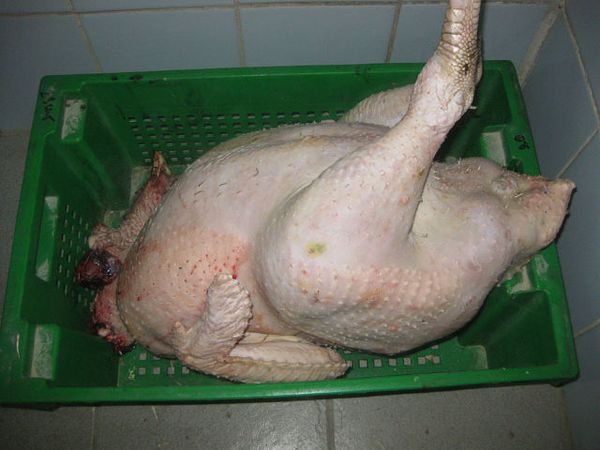
The live weight of males is 20-25 kg, and females 10-12 kg. Characteristics of turkey egg production is up to 100 eggs per year. Females start laying eggs at 7-9 months. Weight of 1 egg - 80 g
Hatching eggs last for 26-28 days. Reducibility - 85%. Slaughter yield - 70-75%. Muscle mass is 80%, of which 30% is on the chest. Per 1 kg increase in live weight is 2 kg of feed.
A day for 1 turkey eats 250-350 g of feed. At 90 days, turkeys weigh 4.5–5 kg, and at 150 days, 11–12 kg. Turkeys are slaughtered in 3-4 months, because after this period the growth of the bird stops.
Feeding and maintenance of turkeys and turkeys
Feeding little turkeys does not pose any difficulties. In the first 3 days of life, chicks are given boiled eggs and boiled cereal porridge.Poults should have unlimited access to water. Feed babies every 3 hours, while the feed must always be fresh.
Finely chopped greens and grated carrots are mixed into the feed. Portions should be small, but enough for turkey hens to eat. On day 4, the ration is made up of wet mash on milk and with the addition of herbs.
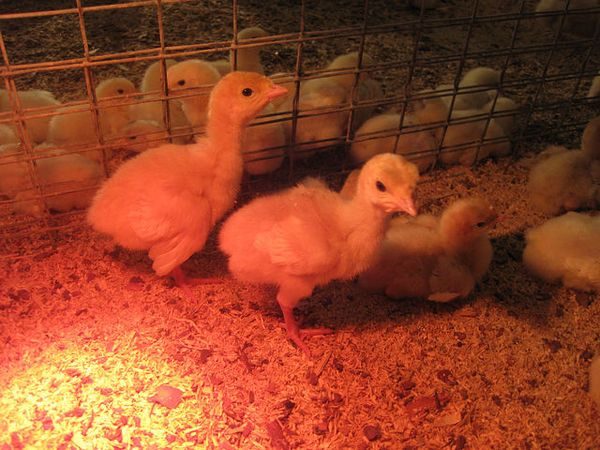
The first 2 months of life for birds is extremely important, so during this period turkeys should be provided with a full-fledged diet, rich in dairy products. It is recommended to feed the cottage cheese, buttermilk, sour milk and the return.
Green forage is considered to be an essential component of the turkey poult diet. Chopped greens of alfalfa, dandelion, nettle, plantain and clover are mixed into the feed. Allowed in the diet add a little green onions, as a preventive measure against intestinal diseases.
As the birds grow, the number of feedings decreases. At 2 months turkeys enough 4 feedings. For feeding the chicks, special feeders are bought or made independently of plywood. In no case can not use metal, because striking with its beak, the turkey can hurt itself.
On day 7, chicks are injected with vitamin D in the diet, a second procedure is carried out after 50 days. On the 15th day nystatin is added to the feed, aimed at preventing aspergillosis. As a preventive measure, chicks from 6 to 11 days are soldered with antibiotics.
Conditions for growing turkey poults
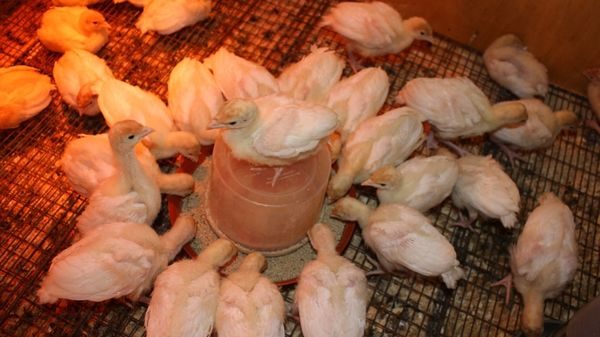
The main requirement for growing turkey poults is the control of the microclimate. The first month of chicks kept in specially designed compartments on litter.
Light day is 12 hours. Indoors are forbidden drafts and high humidity.
If you compare feeding turkeys with other poultry, you will notice some features. Rations for Big 6 are formed with a large amount of protein feeds and vitamins.
What kind of food to give
They feed turkeys 3 times a day, it is undesirable to overfeed these birds, since large individuals are prone to obesity. In the morning and in the afternoon they are fed wet mash with the addition of cereals, and in the evening the turkeys receive dry grain.
Cereals and legumes in turkey rations make up to 65%, most of all turkeys are fed oats and buckwheat. Grain feeds provide turkey with 70% protein and are a source of fat. Oil cakes and oil cakes make up a small percentage of the diet (1-2%), but despite this, birds are fully provided with amino acids.
To provide the body with calcium and phosphorus, meat, meat and bone, fish and blood meal are introduced into the ration of birds. To improve digestion, the body requires fiber, which is contained in hay and straw. In the summer, turkeys are fed grass.
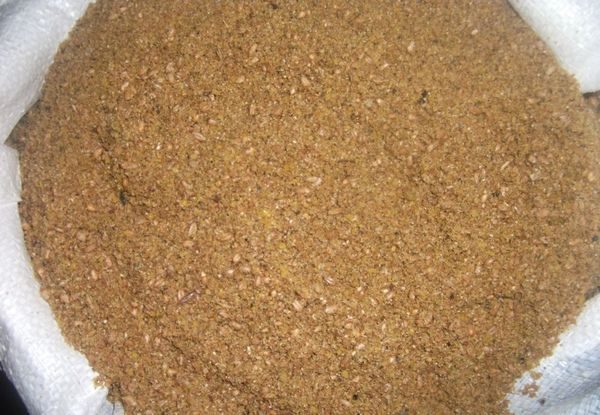
Green fodder, germinated grain and fodder of animal origin are rich in vitamins A, B, E, N. The diet of turkeys is balanced in all elements and vitamins, in the case of their deficiency in young animals the growth slows down, and in adults the egg production decreases.
A detailed description of turkey disease
Newcastle disease. This disease most often affects young animals and causes a great loss. Symptoms: paralysis of the extremities, green-gray-yellow diarrhea, mucous masses accumulate in the goiter. The disease is incurable, and to prevent it, timely vaccination is provided.
Respiratory mycoplasmosis.When this disease is afflicted in birds, the eyes become swollen, coughing and wheezing appear, growth slows down. The mortality rate is minimal. For treatment using various drugs prescribed by a veterinarian.
Aspergillotoksikoz. The disease occurs when eating poor-quality food, can also be a source of litter. The bird becomes inactive, sits on its place, sleeps a lot, breathes often, berates, eats poorly, is stunted and dies suddenly in convulsions.
Gastomonosis. The disease affects the liver and causes diseases of the cecum in young animals. The disease can occur due to poor disinfection of the house. The turkeys have a frothy diarrhea of green-yellow color.
Turkey poults stop eating food, grow weak, lose weight, feathers become disheveled and dirty. The disease is treated with these drugs: furazolidone and osarsol. Also De-worming of turkeys is carried out with such preparations as phenothiazine and piperazine.
The advantages and disadvantages of the breed

Advantages:
- The largest mass cross. Meat turkeys reach 25 kg.
- Precocity. The youngsters quickly gain weight, while at the same time they spend a minimum on fattening.
- The output of meat products is 80%, of which 30% of the breast weighs.
- The plumage in quality is not inferior to the goose and is used in industry for the production of various products.
- When compared with other species, then Big 6 bears more eggs.
Disadvantages:
- Poor cold and dampness, which entails the cost of warming and heating the house in winter.
- Turkeys have poor contact with each other and with other birds, so they keep them in separate rooms and families.
Conclusion
Big 6 belongs to the meat cross-country and is considered a heavyweight of its kind. The turkeys in the care are unpretentious, and to get the benefits it is enough to follow a few rules of feeding and growing. Given that the birds are growing rapidly and consume a little feed, during the season you can grow more than one kilogram of tasty meat.
It is believed that turkey meat has the best taste compared with chicken, it is dietary and well absorbed in the body.
Reviews
For some reason, it is considered that raising turkeys is a troublesome task.Nothing like this! It is necessary to devote time and effort no less than chickens and ducks, and there are 2 or even 3 times more meat. Yes, there are some nuances, but they are present in any agricultural animal.
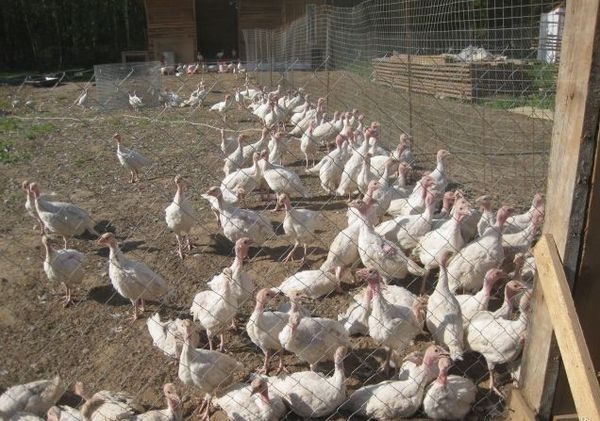
There are no flaws in the breed, it is almost perfect, to the tips of its snow-white feathers. Big 6 is bred not only for the sake of meat, but also for the sake of a feather. With proper feeding and maintenance, the young grows healthy and strong. Cross Big 6 is the best of the currently existing species.
Since the cross Big 6 appeared relatively recently, then it can be found not in all the yards, but only at breeders engaged professionally.
Chicks hatch, as under the turkey, and in the incubator. Adult birds look very beautiful, especially males. Maintenance at home does not require any frills and heavy technology. Even a novice farmer can handle it: a spacious warm shed, without drafts and dampness.
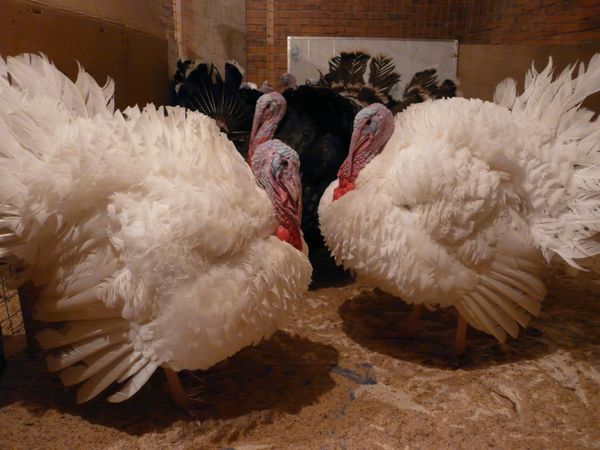
At what age and at what mass is the most appropriate slaughter of males of this breed? It seems to me that with a weight of 15-18 kg, further cultivation becomes unprofitable, the feed spent will not pay off. Or am I wrong?
Where can I buy the Big 6 breed in Kazakhstan
Sultan, unfortunately I do not know. You better search the local market.
In the shortcomings, I would include the impossibility of fertilization of females by males because of the large weight. Artificial insemination is necessary. Here, for some reason, they don’t write about it. And in general, I liked the breed. I cared for chickens, but there was a lot of meat. When they were killed, the carcass was hung up together.